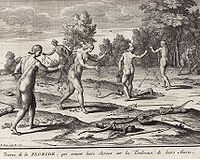
Bernard Picart
Encyclopedia

France
The French Republic , The French Republic , The French Republic , (commonly known as France , is a unitary semi-presidential republic in Western Europe with several overseas territories and islands located on other continents and in the Indian, Pacific, and Atlantic oceans. Metropolitan France...
engraver, son of Etienne Picart, also an engraver. He was born in Paris
Paris
Paris is the capital and largest city in France, situated on the river Seine, in northern France, at the heart of the Île-de-France region...
and died in Amsterdam
Amsterdam
Amsterdam is the largest city and the capital of the Netherlands. The current position of Amsterdam as capital city of the Kingdom of the Netherlands is governed by the constitution of August 24, 1815 and its successors. Amsterdam has a population of 783,364 within city limits, an urban population...
. He moved to Antwerp in 1696, and then spent a year in Amsterdam before returning to France at the end of 1698. After his wife died in 1708, he moved to Amsterdam in 1711 (later being joined by his father), where he became a Protestant convert and married again.
Most of his work was book-illustrations. His most famous work is Cérémonies et coutumes religieuses de tous les peuples du monde, appearing from 1723 to 1743. Jonathan I. Israel calls Cérémonies "an immense effort to record the religious rituals and beliefs of the world in all their diversity as objectively and authentically as possible". Although Picart had never left Europe, he relied on accounts by those who had and had access to a collection of Indian sculpture. The original French edition of Cérémonies comprises ten volumes of text and engravings.
Israel notes also that Picart left Paris with Prosper Marchand, and collaborated on the Cérémonies with Jean-Frédéric Bernard, with a commitment to religious toleration
Religious toleration
Toleration is "the practice of deliberately allowing or permitting a thing of which one disapproves. One can meaningfully speak of tolerating, ie of allowing or permitting, only if one is in a position to disallow”. It has also been defined as "to bear or endure" or "to nourish, sustain or preserve"...
. Picart, Marchand and Charles Levier belonged to a "radical Huguenot coterie".
"Cérémonies" engravings
- Vol. 1: Asie, Afrique and Amérique (Asia, Africa and America)- 30 engravings
- Vol. 2 - 33 engravings
- Vol. 3 - 19 engravings
- Vol. 4 - 14 engravings
- Vol. 5 - 26 engravings
- Vol. 6 - 45 engravings
- Vol. 7 - 58 engravings
- Vol. 8 - 5 engravings
- Vol. 9 - 24 engravings
- Vol. 10- 12 engravings

